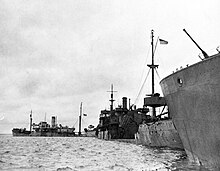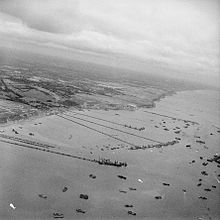SS West Nohno
 West Nohno had design and measurements similar to West Shore, a sister ship from the same shipyard seen here c. 1918.
| |
| History | |
|---|---|
| Name | West Nohno |
| Owner | USSB |
| Builder | |
| Yard number | 24[2] |
| Launched | 12 February 1919[3] |
| Completed | May 1919[2] |
| Identification | Official number: 217936[1] |
| Fate | Sunk as part of "gooseberry" breakwater off Normandy, 11 June 1944[4] |
| General characteristics | |
| Type | Design 1013 ship |
| Tonnage | |
| Length | |
| Beam | 54 ft 2 in (16.51 m)[1] |
| Draft | 23 ft 11 in (7.29 m)[5] |
| Propulsion | 1 × steam turbine[1] |
| Speed | 11.5 knots (21.3 km/h)[1] |
SS West Nohno was a
West Nohno was built in 1919 for the USSB, as a part of the West ships, a series of steel-
In November 1941, West Nohno became the first American merchant ship to be armed prior to the United States' entry into
Design and construction
The West ships were
West Nohno was 6,186
Early career
West Nohno was inspected by the United States Navy after completion for possible use and was assigned the identification number of 4029. Had she been commissioned, she would have been known as USS West Nohno (ID-4029), but the Navy neither took over the ship nor commissioned her.[7]
Information on West Nohno's early career is incomplete, but through the end of 1920 the cargo ship sailed on a New York –
From 1928 to 1941, little is known about West Nohno's activities. At some point during this period, she was laid up as part of a
World War II

When amendments to the U.S.
After her guns were installed, West Nohno had made her way to
West Nohno had made her way to
In February 1943, the West Nohno completed her nine-month journey when she arrived at

In late March, West Nohno began the first of three
Final voyage
West Nohno had been selected to become one of the


West Nohno departed Boston on 24 February and arrived at Halifax two days later. Departing from that port on 29 February, she sailed in Convoy HX-281 and arrived at Milford Haven on 15 March. She departed there for Portsmouth the same day.[20] West Nohno's whereabouts and movements through early June are not recorded. Other ships that had been selected as blockships assembled in a "corncob" fleet at Oban,[28] though it's not clear if West Nohno did or not. The "corncob" fleet was the group of ships intended to be sunk to form the "gooseberries",[29] shallow-water artificial harbors for landing craft.[30] Poropat reports that once the ship crews were told of their mission while anchored at Oban, they were not permitted to leave the ships.[28]
Three "corncob" convoys, consisting of what one author called the "dregs of the North Atlantic shipping pool",
Awards
Harold T. Andrews was an ordinary seaman on the SS West Nohno on 15 September 1942 when the ship was in
Notes
- ^ There is no record of any specific attack on West Nohno while at Murmansk, but Yaka, another American cargo ship, experienced 48 air attacks in a nine-day period in April. See: Morison, p. 372.
- St. Olav's medal with Oak Branch was awarded posthumously in 1989. See: Lawson, Siri (12 August 2008). "M/T Britannia". Norwegian Merchant Fleet 1939-1945. WarSailors.com. Retrieved 6 November 2008.
References
- ^ a b c d e f g h "West Nohno". Miramar Ship Index. R.B.Haworth. Retrieved 12 September 2008.
- ^ a b c d e Colton, Tim. "Northwest Steel, Portland OR". Shipbuildinghistory.com. The Colton Company. Retrieved 12 September 2008.
- ^ OCLC 8414304.
- ^ a b Stanford, p. 149.
- ^ a b c d e Jordan, p. 433.
- ^ Crowell and Wilson, pp. 358–59.
- ^ a b c Naval Historical Center. "West Nohno". DANFS.
- ^ Naval Historical Center. "West Cheswald". DANFS.
- ^ See: "Shipping and mails" (PDF). The New York Times. 16 August 1919. p. 14. Retrieved 12 September 2008. Also: "Shipping". The Times. 17 March 1920. p. 2. "Mail and shipping intelligence". The Times. 26 April 1920. p. 24. "Mail and shipping intelligence". The Times. 17 December 1920. p. 17.
- ^ a b "African line bids to be opened today". The New York Times. 29 May 1928. p. 51.
- ^ "Shipping and mails" (PDF). The New York Times. 8 September 1922. p. 23. Retrieved 12 September 2008.
- ^ "Shipping and mails" (PDF). The New York Times. 12 December 1922. p. 39. Retrieved 12 September 2008.
- ^ "Shipping and mails". The New York Times. 3 January 1923. p. 14.
- ^ "Shipping and mails". The New York Times. 19 January 1923. p. 35.
- ^ "Shipping and mails". The New York Times. 9 March 1923. p. 19.
- ^ "Shipping and mails". The New York Times. 7 November 1923. p. 35.
- ^ "U.S. Gets 40 ships for defense pool". The New York Times. 14 May 1941. p. 8.
- ^ a b "First U.S. cargo ship is armed amid both secrecy and fanfare". The New York Times. 27 November 1941. p. 1.
- ^ Cressman, p. 69.
- ^ a b c d e f g "Port Arrivals/Departures: West Nohno". Arnold Hague's Ports Database. Convoy Web. Retrieved 12 September 2008.
- ^ a b Morison, pp. 370–71.
- ^ a b c "CIO seamen plan a revolt, court is told". Chicago Daily Tribune. 5 August 1943. p. 1.
- ^ a b Lawson, Siri (12 August 2008). "M/T Britannia". Norwegian Merchant Fleet 1939-1945. WarSailors.com. Retrieved 6 November 2008.
- ^ Lawson, Siri (12 August 2008). "Norwegian War Medals". Norwegian Merchant Fleet 1939-1945. WarSailors.com. Retrieved 6 November 2008.
- ^ "CIO aid gets 5-year term as seditionist". Chicago Daily Tribune. 7 August 1943. p. 1.
- ^ "Convoy SC.126". Arnold Hague Convoy Database. ConvoyWeb. Retrieved 12 September 2008.
- ^ Stone, Leon (18 November 1944). "Bay State ship sacrificed to Normandy aid". The Christian Science Monitor. p. 5.
- ^ a b c d Poropat, Cesar (2000). "The Corncob Fleet on D-Day". Beyond the Palisades. Bruce Poropat. Retrieved 12 September 2008. This webpage consists of excerpts from Cesar Poropat's privately published 2000 book, Beyond the Palisades.
- ^ Richard, Glossary of U.S. Naval Code Words: C.
- ^ Richard, Glossary of U.S. Naval Code Words: G.
- ^ Howe, p. 1.
- ^ "Convoy CORNCOB.1", "Convoy CORNCOB.2", "Convoy CORNCOB.3". Arnold Hague Convoy Database. ConvoyWeb. Retrieved 12 September 2008.
- ^ Howe, p. 3.
- ^ a b Askew, pp. 179–80.
- ^ Crichton, Tom (4 April 2004). T. Horodysky (ed.). "The Useful Death of the MV Galveston". American Merchant Marine at War. T. Horodysky. Retrieved 12 September 2008.
- ^ usmm.org Heroes
Bibliography
- Askew, William C.; Director of Naval History (1946). History of the Naval Armed Guard Afloat: World War II (OP-414). United States Naval Administration in World War II: Office of Naval Operations. Washington, D.C.: Navy Department.
- Cressman, Robert (2000). "Chapter IV: 1942". The Official Chronology of the U.S. Navy in World War II. Annapolis, Maryland: Naval Institute Press. OCLC 41977179. Retrieved 12 September 2008.
- OCLC 18696066.
- Howe, Hartley E. (June 2004). "D-Day's Secret Weapons: Mullberries, Whales, Gooseberries, Phoenix, & Pluto". Sea Classics. OCLC 60621086.
- Jordan, Roger W. (2006) [1999]. The World's Merchant Fleets, 1939: The Particulars And Wartime Fates of 6,000 Ships. OCLC 150361480.
- OCLC 7395406.
- Naval Historical Center. "West Cheswald". Dictionary of American Naval Fighting Ships. Navy Department, Naval History and Heritage Command. Retrieved 12 September 2008.
- Naval Historical Center. "West Nohno". Dictionary of American Naval Fighting Ships. Navy Department, Naval History & Heritage Command. Retrieved 12 September 2008.
- Richard, Dorothy Elizabeth; Office of Naval History (1947). Glossary of U.S. naval code words. Washington, D.C.: OCLC 51039630. Retrieved 12 September 2008.
- Stanford, Alfred (1951). Force Mulberry: The Planning and Installation of the Artificial Harbor Off U.S. Normandy Beaches in World War II. New York: Morrow. OCLC 576288.
